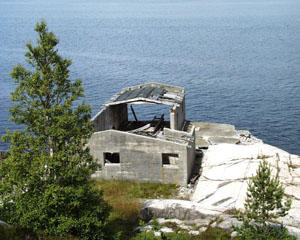Krigsminne
Forfatter: Gulen kommune
Publiseringsdato: 22.02.2001

Anlegg i Rutledal. Foto: Scandion.
På strendene langs med ytre delen av Sognefjorden
i Gulen etablerte tyskarane under 2. verdskrigen ei rekkje militære
anlegg og støttepunkt. Ruinane etter fleire av desse er i dag synlege
- mellom anna både i øvre og nedre del av Rutledalen og på
Riseneset. Anlegget og mannskapsstyrken på 14 mann i Rutledal stod
klart i mai 1940. Kampoppdrag var i samarbeid med kanonbatteriet på
Nesje i Hyllestad å sperre innlaupet til Sognefjorden.
Det noko større anlegget på Riseneset bestod
av ein styrke på 121 mann som rådde over 4 feltkanonar og 2
luftvernkanonar i hovudforsvaret, 2 vognkanonar, 2 mitraljøser og
12 flammekastarar i nærforsvaret og eit luftvern med 2 Flak 38 luftvernkanonar.
Anlegget stod ferdig i september 1942 og skulle kjempe mot sjømål
på Sognesjøen, sperre innlaupet til Sognefjorden, kontrollere
og verne skipsleia over Sognesjøen og gjennom Krakhellesundet, samt
sikre eigne skip og konvoiar i området.
I samband med etableringa av og forsyninga til desse anlegga,
bygde tyskarane veg langsmed Sognefjorden. Den noverande vegen (Rv 57)
frå Brekke til Rutledal er lagt oppå denne traséen,
men på neset mellom Rutledal og Breidvika er eit stykkje av den opphavlege
vegen framleis synleg og farbar som turveg.
------------------------------------------------------------------
War memorials
Information: Gulen Municipality
(23.01.2003)
During World War II the Germans established several military
installations and points of support along and in the outer parts at Gulen.
Several of the ruins are still visible and partly accessible, such as those
in the upper and lower part at the Rutledal and at Riseneset.
The buildings and a 14 men troop were established at Rutledal
in May 1940. The batallion co-operated with the canons at Nesje fort in
Hyllestad to block the inlet of the Sognefjord.
A larger installation at Riseneset consisted of a force
of 121 men with 4 field canons and 2 air defence canons for their main
support, 2 carriage canons, 2 machine guns and 12 flame throwers as a close
support and an air support of 2 Flak air defence conons. This fort was
completed in Sept. 1942 and was meant to combat sea targets and to block
the inlet to the Sognefjord, control and protect the shipping lane across
the Sognefjord and through the Krakhelle strait in addition to protecting
the German ships and convoys in the area.
In connection with the establishing and supply of these
military installations the Germans built a road along the Sognefjord.
The existing Rv 57 from Brekke towards the coost goes
along this road, but at the peninsular between Rutledal and Breidvika and
parts of the original road are still visible and suited for walking. |




